Coordination of Business Resources: A Comprehensive Report
VerifiedAdded on 2020/04/21
|14
|2543
|108
Report
AI Summary
This report comprehensively examines the coordination of business resources within a university setting. It begins with an overview of procurement processes, emphasizing the importance of open competition, ethical behavior, and adherence to regulations. The report then delves into facilities management, highlighting its role in maintaining the university's infrastructure and ensuring a safe environment. A significant portion is dedicated to health and safety policies, outlining the essential components of a written policy and the importance of regular reviews and inspections. The report further explores the role of budgets, resource allocation, and performance management in operational planning. It also discusses the crucial aspects of project monitoring, including data collection, tool selection, and responsibility assignment. Finally, the report addresses workplace inspections, emphasizing their role in hazard identification and prevention, and the importance of considering all workplace elements and hazard types. The report concludes by touching upon the use of marketing and branding programs, the transformation role of operations management, and the benefits of collaborative activities.
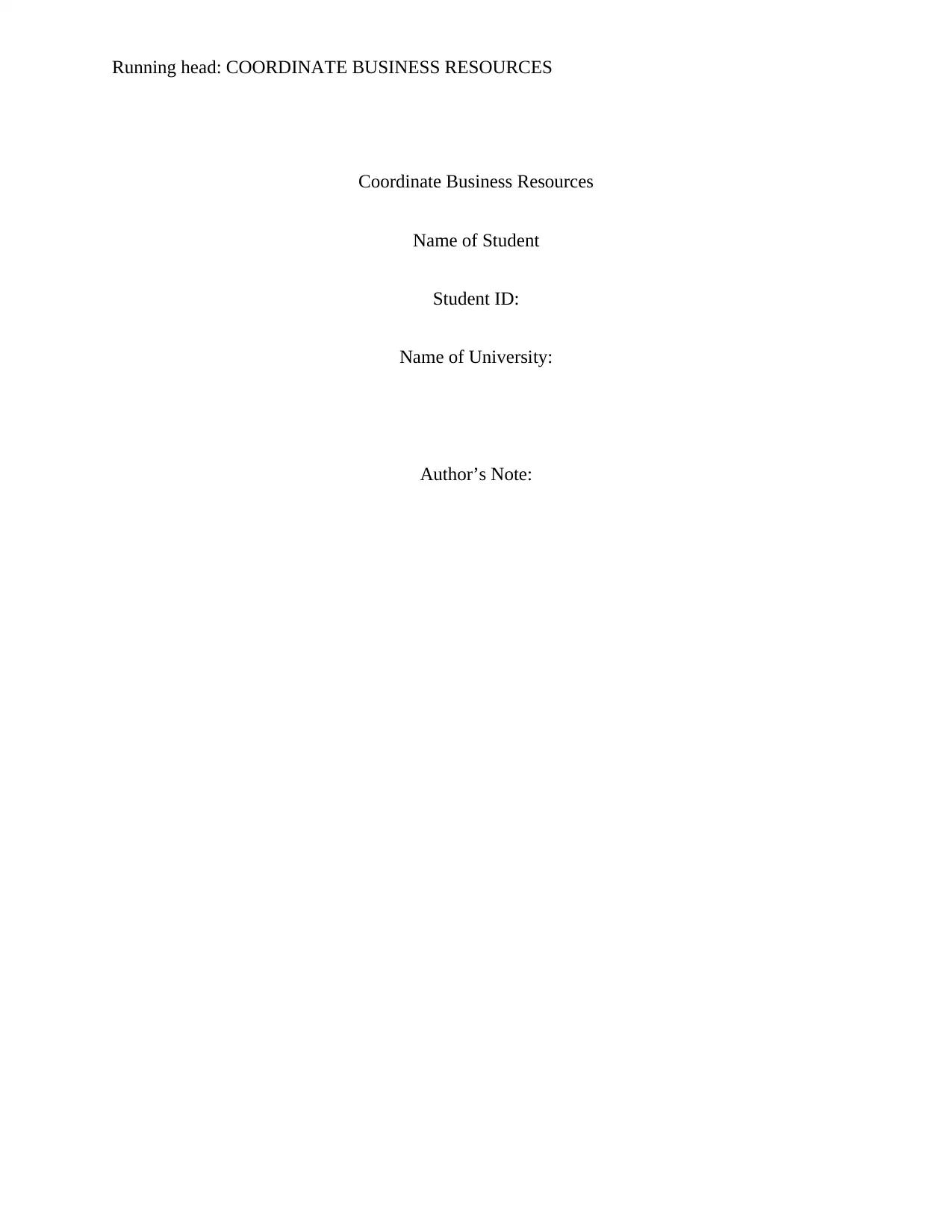
Running head: COORDINATE BUSINESS RESOURCES
Coordinate Business Resources
Name of Student
Student ID:
Name of University:
Author’s Note:
Coordinate Business Resources
Name of Student
Student ID:
Name of University:
Author’s Note:
Paraphrase This Document
Need a fresh take? Get an instant paraphrase of this document with our AI Paraphraser
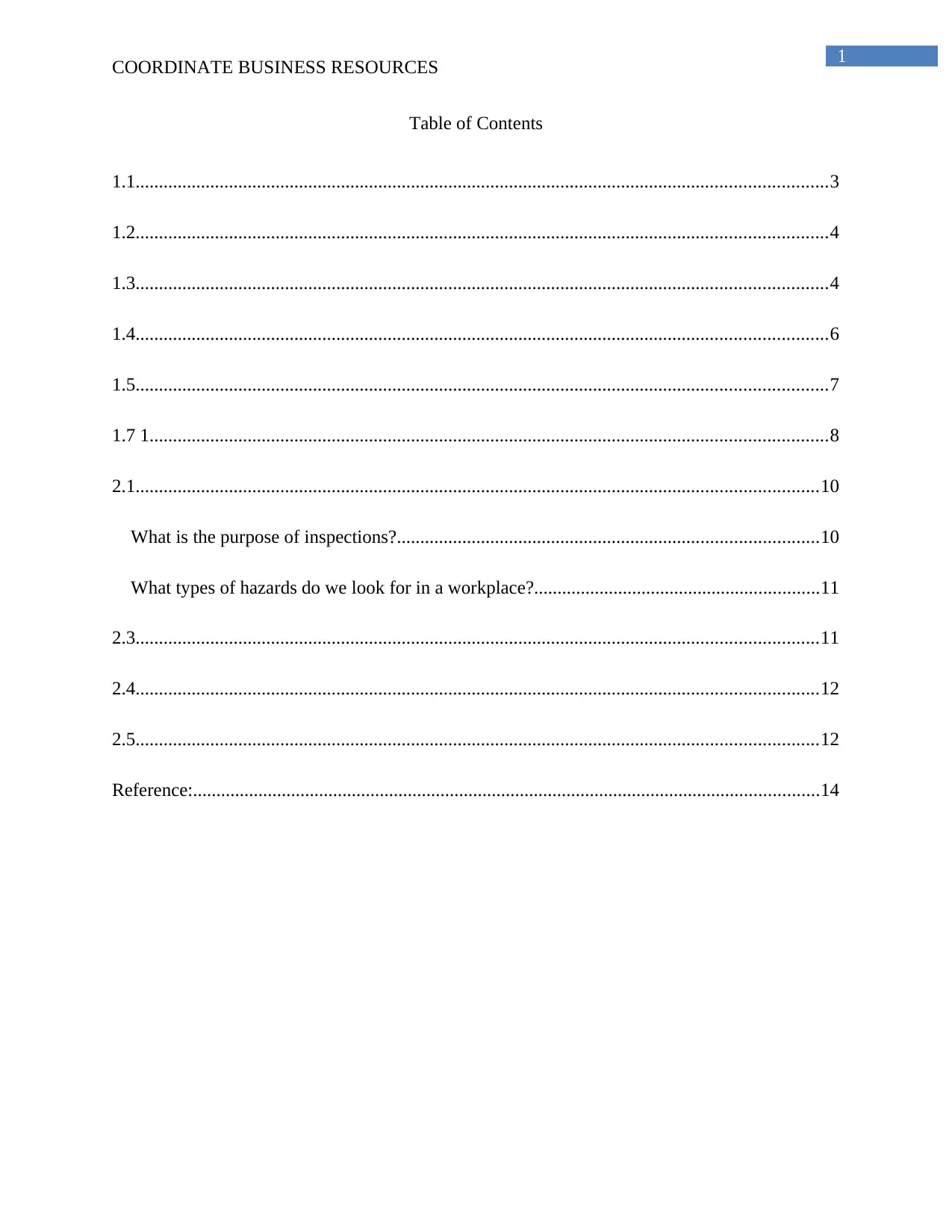
1
COORDINATE BUSINESS RESOURCES
Table of Contents
1.1....................................................................................................................................................3
1.2....................................................................................................................................................4
1.3....................................................................................................................................................4
1.4....................................................................................................................................................6
1.5....................................................................................................................................................7
1.7 1.................................................................................................................................................8
2.1..................................................................................................................................................10
What is the purpose of inspections?..........................................................................................10
What types of hazards do we look for in a workplace?.............................................................11
2.3..................................................................................................................................................11
2.4..................................................................................................................................................12
2.5..................................................................................................................................................12
Reference:......................................................................................................................................14
COORDINATE BUSINESS RESOURCES
Table of Contents
1.1....................................................................................................................................................3
1.2....................................................................................................................................................4
1.3....................................................................................................................................................4
1.4....................................................................................................................................................6
1.5....................................................................................................................................................7
1.7 1.................................................................................................................................................8
2.1..................................................................................................................................................10
What is the purpose of inspections?..........................................................................................10
What types of hazards do we look for in a workplace?.............................................................11
2.3..................................................................................................................................................11
2.4..................................................................................................................................................12
2.5..................................................................................................................................................12
Reference:......................................................................................................................................14
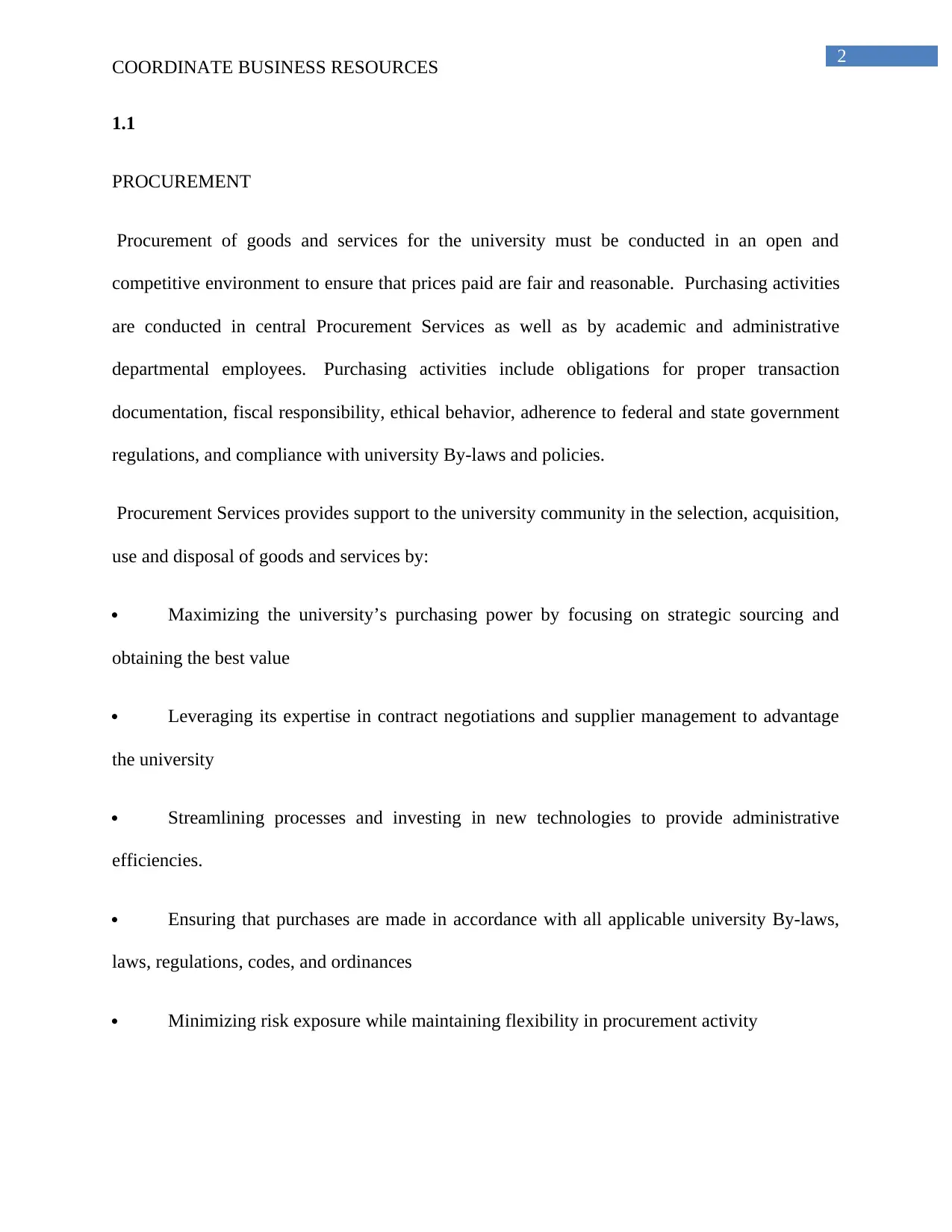
2
COORDINATE BUSINESS RESOURCES
1.1
PROCUREMENT
Procurement of goods and services for the university must be conducted in an open and
competitive environment to ensure that prices paid are fair and reasonable. Purchasing activities
are conducted in central Procurement Services as well as by academic and administrative
departmental employees. Purchasing activities include obligations for proper transaction
documentation, fiscal responsibility, ethical behavior, adherence to federal and state government
regulations, and compliance with university By-laws and policies.
Procurement Services provides support to the university community in the selection, acquisition,
use and disposal of goods and services by:
Maximizing the university’s purchasing power by focusing on strategic sourcing and
obtaining the best value
Leveraging its expertise in contract negotiations and supplier management to advantage
the university
Streamlining processes and investing in new technologies to provide administrative
efficiencies.
Ensuring that purchases are made in accordance with all applicable university By-laws,
laws, regulations, codes, and ordinances
Minimizing risk exposure while maintaining flexibility in procurement activity
COORDINATE BUSINESS RESOURCES
1.1
PROCUREMENT
Procurement of goods and services for the university must be conducted in an open and
competitive environment to ensure that prices paid are fair and reasonable. Purchasing activities
are conducted in central Procurement Services as well as by academic and administrative
departmental employees. Purchasing activities include obligations for proper transaction
documentation, fiscal responsibility, ethical behavior, adherence to federal and state government
regulations, and compliance with university By-laws and policies.
Procurement Services provides support to the university community in the selection, acquisition,
use and disposal of goods and services by:
Maximizing the university’s purchasing power by focusing on strategic sourcing and
obtaining the best value
Leveraging its expertise in contract negotiations and supplier management to advantage
the university
Streamlining processes and investing in new technologies to provide administrative
efficiencies.
Ensuring that purchases are made in accordance with all applicable university By-laws,
laws, regulations, codes, and ordinances
Minimizing risk exposure while maintaining flexibility in procurement activity
⊘ This is a preview!⊘
Do you want full access?
Subscribe today to unlock all pages.

Trusted by 1+ million students worldwide
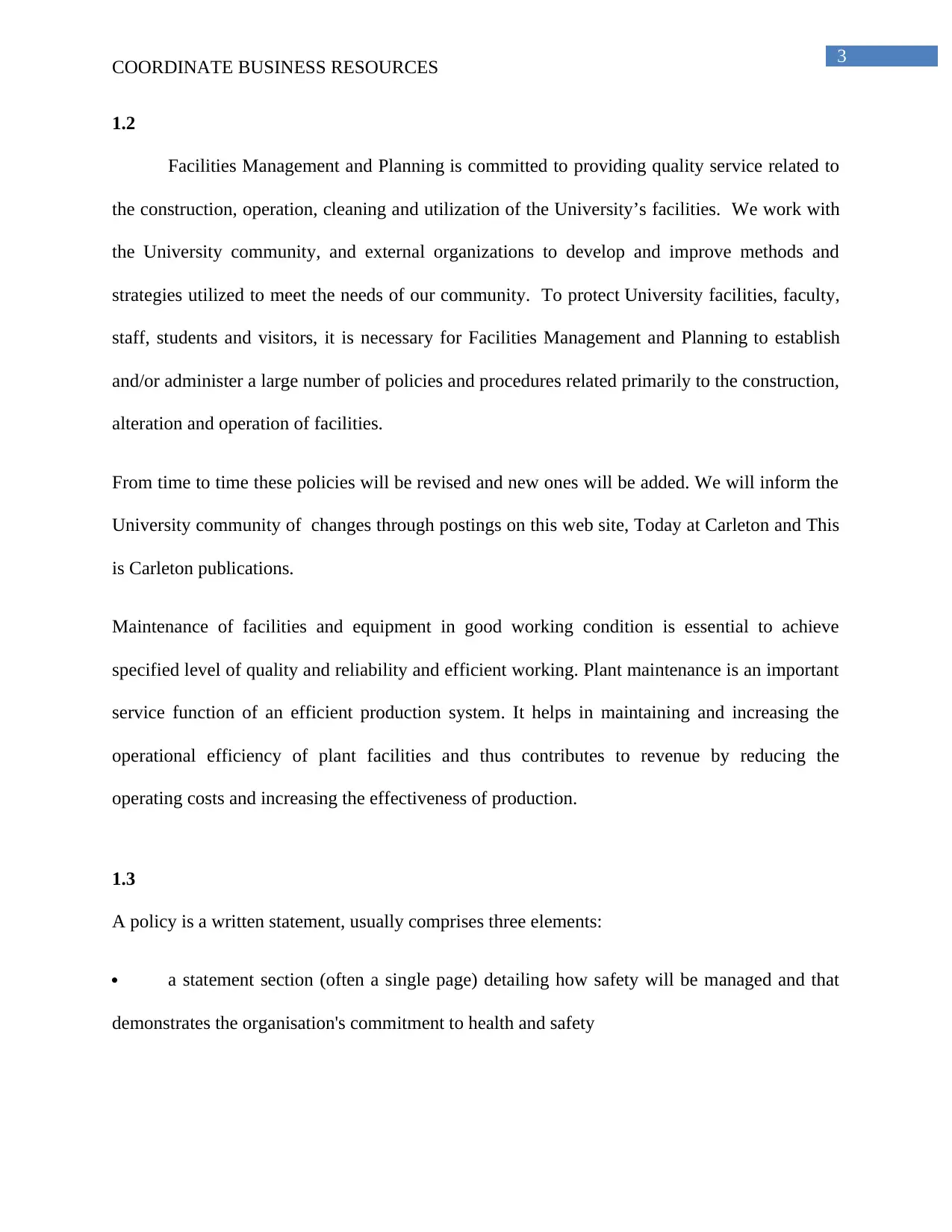
3
COORDINATE BUSINESS RESOURCES
1.2
Facilities Management and Planning is committed to providing quality service related to
the construction, operation, cleaning and utilization of the University’s facilities. We work with
the University community, and external organizations to develop and improve methods and
strategies utilized to meet the needs of our community. To protect University facilities, faculty,
staff, students and visitors, it is necessary for Facilities Management and Planning to establish
and/or administer a large number of policies and procedures related primarily to the construction,
alteration and operation of facilities.
From time to time these policies will be revised and new ones will be added. We will inform the
University community of changes through postings on this web site, Today at Carleton and This
is Carleton publications.
Maintenance of facilities and equipment in good working condition is essential to achieve
specified level of quality and reliability and efficient working. Plant maintenance is an important
service function of an efficient production system. It helps in maintaining and increasing the
operational efficiency of plant facilities and thus contributes to revenue by reducing the
operating costs and increasing the effectiveness of production.
1.3
A policy is a written statement, usually comprises three elements:
a statement section (often a single page) detailing how safety will be managed and that
demonstrates the organisation's commitment to health and safety
COORDINATE BUSINESS RESOURCES
1.2
Facilities Management and Planning is committed to providing quality service related to
the construction, operation, cleaning and utilization of the University’s facilities. We work with
the University community, and external organizations to develop and improve methods and
strategies utilized to meet the needs of our community. To protect University facilities, faculty,
staff, students and visitors, it is necessary for Facilities Management and Planning to establish
and/or administer a large number of policies and procedures related primarily to the construction,
alteration and operation of facilities.
From time to time these policies will be revised and new ones will be added. We will inform the
University community of changes through postings on this web site, Today at Carleton and This
is Carleton publications.
Maintenance of facilities and equipment in good working condition is essential to achieve
specified level of quality and reliability and efficient working. Plant maintenance is an important
service function of an efficient production system. It helps in maintaining and increasing the
operational efficiency of plant facilities and thus contributes to revenue by reducing the
operating costs and increasing the effectiveness of production.
1.3
A policy is a written statement, usually comprises three elements:
a statement section (often a single page) detailing how safety will be managed and that
demonstrates the organisation's commitment to health and safety
Paraphrase This Document
Need a fresh take? Get an instant paraphrase of this document with our AI Paraphraser
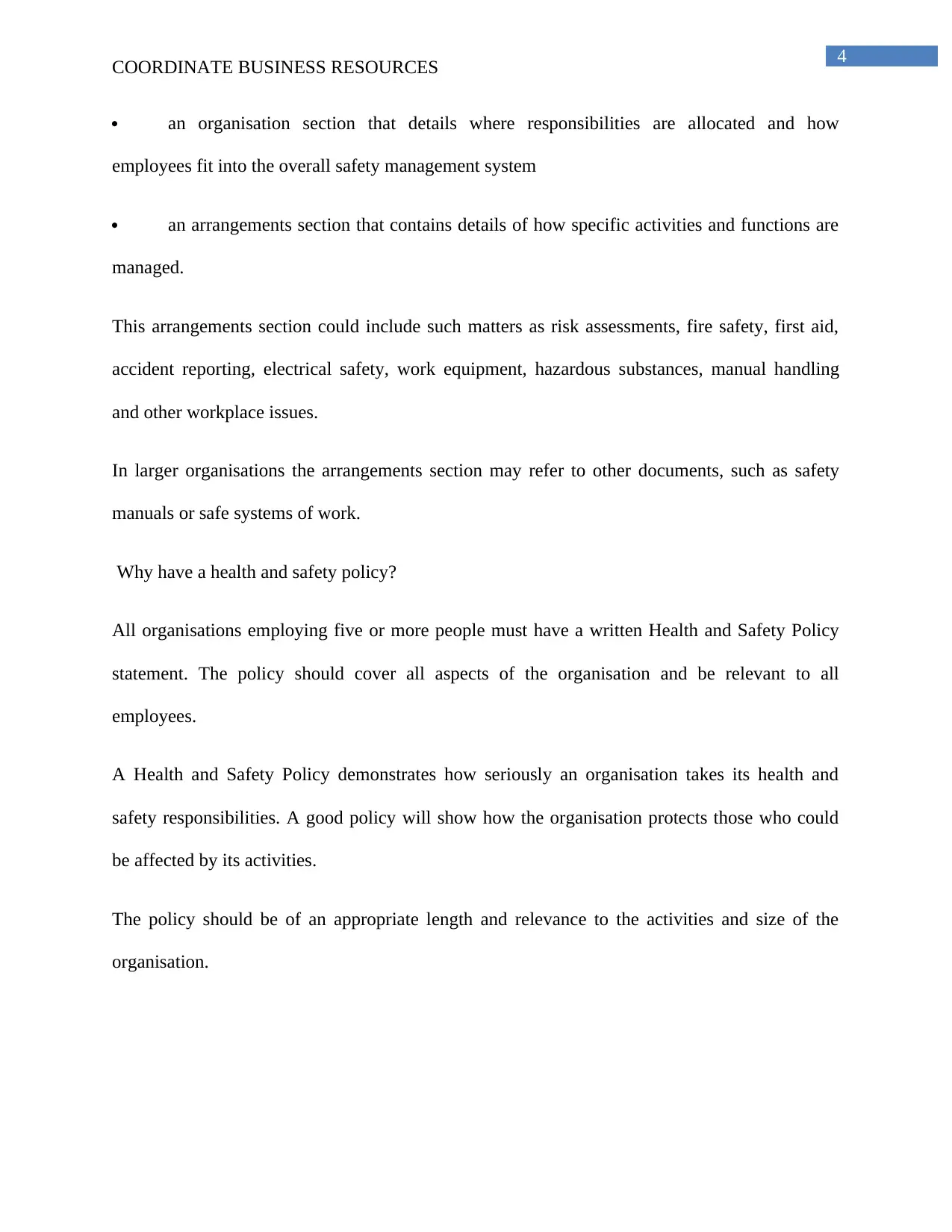
4
COORDINATE BUSINESS RESOURCES
an organisation section that details where responsibilities are allocated and how
employees fit into the overall safety management system
an arrangements section that contains details of how specific activities and functions are
managed.
This arrangements section could include such matters as risk assessments, fire safety, first aid,
accident reporting, electrical safety, work equipment, hazardous substances, manual handling
and other workplace issues.
In larger organisations the arrangements section may refer to other documents, such as safety
manuals or safe systems of work.
Why have a health and safety policy?
All organisations employing five or more people must have a written Health and Safety Policy
statement. The policy should cover all aspects of the organisation and be relevant to all
employees.
A Health and Safety Policy demonstrates how seriously an organisation takes its health and
safety responsibilities. A good policy will show how the organisation protects those who could
be affected by its activities.
The policy should be of an appropriate length and relevance to the activities and size of the
organisation.
COORDINATE BUSINESS RESOURCES
an organisation section that details where responsibilities are allocated and how
employees fit into the overall safety management system
an arrangements section that contains details of how specific activities and functions are
managed.
This arrangements section could include such matters as risk assessments, fire safety, first aid,
accident reporting, electrical safety, work equipment, hazardous substances, manual handling
and other workplace issues.
In larger organisations the arrangements section may refer to other documents, such as safety
manuals or safe systems of work.
Why have a health and safety policy?
All organisations employing five or more people must have a written Health and Safety Policy
statement. The policy should cover all aspects of the organisation and be relevant to all
employees.
A Health and Safety Policy demonstrates how seriously an organisation takes its health and
safety responsibilities. A good policy will show how the organisation protects those who could
be affected by its activities.
The policy should be of an appropriate length and relevance to the activities and size of the
organisation.
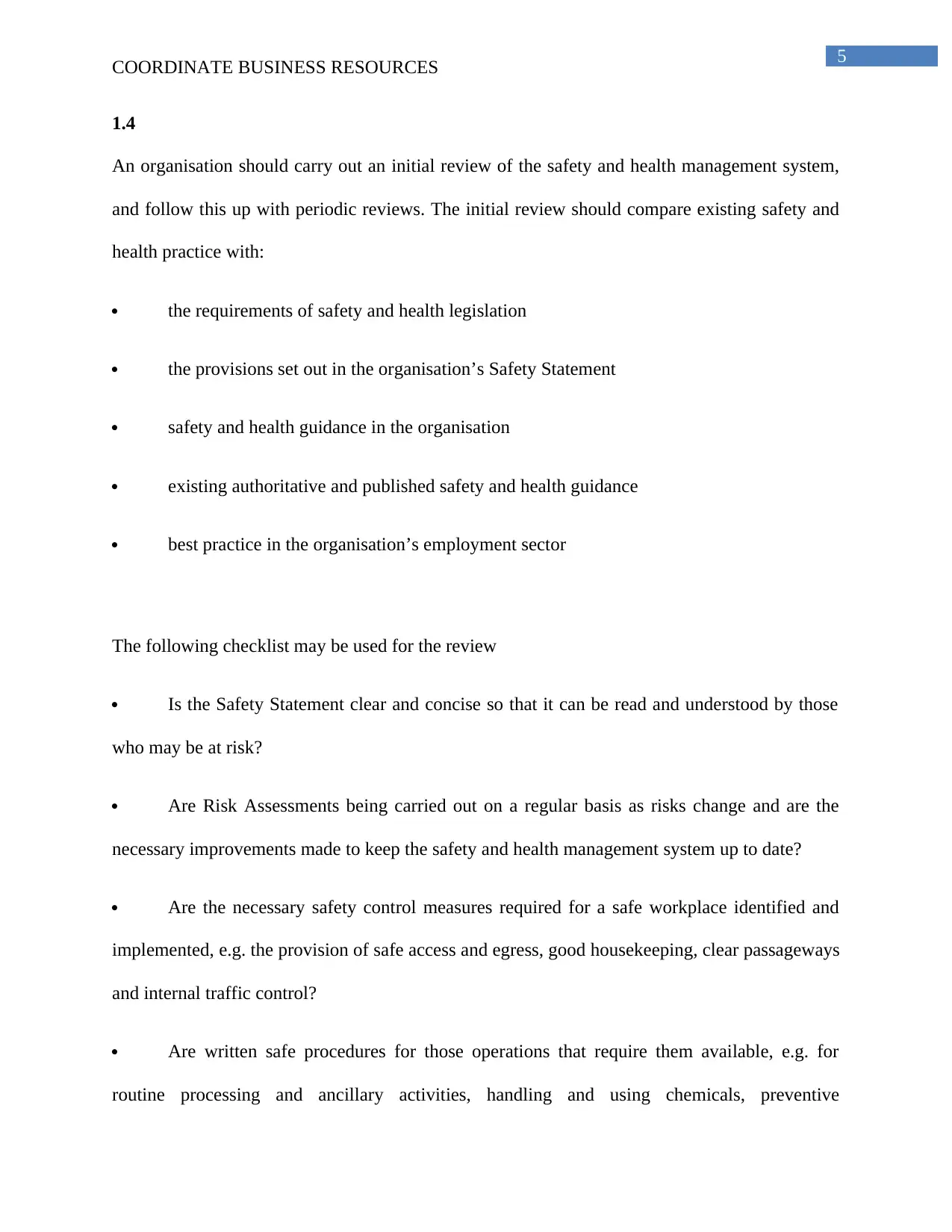
5
COORDINATE BUSINESS RESOURCES
1.4
An organisation should carry out an initial review of the safety and health management system,
and follow this up with periodic reviews. The initial review should compare existing safety and
health practice with:
the requirements of safety and health legislation
the provisions set out in the organisation’s Safety Statement
safety and health guidance in the organisation
existing authoritative and published safety and health guidance
best practice in the organisation’s employment sector
The following checklist may be used for the review
Is the Safety Statement clear and concise so that it can be read and understood by those
who may be at risk?
Are Risk Assessments being carried out on a regular basis as risks change and are the
necessary improvements made to keep the safety and health management system up to date?
Are the necessary safety control measures required for a safe workplace identified and
implemented, e.g. the provision of safe access and egress, good housekeeping, clear passageways
and internal traffic control?
Are written safe procedures for those operations that require them available, e.g. for
routine processing and ancillary activities, handling and using chemicals, preventive
COORDINATE BUSINESS RESOURCES
1.4
An organisation should carry out an initial review of the safety and health management system,
and follow this up with periodic reviews. The initial review should compare existing safety and
health practice with:
the requirements of safety and health legislation
the provisions set out in the organisation’s Safety Statement
safety and health guidance in the organisation
existing authoritative and published safety and health guidance
best practice in the organisation’s employment sector
The following checklist may be used for the review
Is the Safety Statement clear and concise so that it can be read and understood by those
who may be at risk?
Are Risk Assessments being carried out on a regular basis as risks change and are the
necessary improvements made to keep the safety and health management system up to date?
Are the necessary safety control measures required for a safe workplace identified and
implemented, e.g. the provision of safe access and egress, good housekeeping, clear passageways
and internal traffic control?
Are written safe procedures for those operations that require them available, e.g. for
routine processing and ancillary activities, handling and using chemicals, preventive
⊘ This is a preview!⊘
Do you want full access?
Subscribe today to unlock all pages.

Trusted by 1+ million students worldwide

6
COORDINATE BUSINESS RESOURCES
maintenance, plant and equipment breakdown maintenance, accident and ill-health
investigations, emergency planning, assessment of personal protective equipment (PPE)
requirements?
Do safety consultation, employee participation and representation procedures exist and
are these procedures effective, e.g. is there good co-operation between employer, managers and
employees on safety and health issues at the workplace? Is there a safety committee in existence
and if so does it comply with the 2005 Act requirements? Are safety committee meetings
constructive with meeting reports and follow-up action lists? Is the safety representative or
representatives involved at every stage of the safety consultation process?
1.5
Budgets
The primary financial link between a strategic plan and an operational plan is the establishment
of a departmental budget. The strategic plan gives a budget estimate that is based on projected
revenue. The operational plan gives a more accurate number that can be used to gauge the
success of a strategic plan. If the operational budget is more than the strategic plan provides for,
then the company needs to work to bring the two numbers more in line.
Resource Allocation
An operational plan is used to determine job duties and the proper use of company resources,
such as equipment and facilities. A strategic plan outlines what kind of resource allocation is
needed to achieve the goals of the plan. The operational and strategic plan are then put side-by-
COORDINATE BUSINESS RESOURCES
maintenance, plant and equipment breakdown maintenance, accident and ill-health
investigations, emergency planning, assessment of personal protective equipment (PPE)
requirements?
Do safety consultation, employee participation and representation procedures exist and
are these procedures effective, e.g. is there good co-operation between employer, managers and
employees on safety and health issues at the workplace? Is there a safety committee in existence
and if so does it comply with the 2005 Act requirements? Are safety committee meetings
constructive with meeting reports and follow-up action lists? Is the safety representative or
representatives involved at every stage of the safety consultation process?
1.5
Budgets
The primary financial link between a strategic plan and an operational plan is the establishment
of a departmental budget. The strategic plan gives a budget estimate that is based on projected
revenue. The operational plan gives a more accurate number that can be used to gauge the
success of a strategic plan. If the operational budget is more than the strategic plan provides for,
then the company needs to work to bring the two numbers more in line.
Resource Allocation
An operational plan is used to determine job duties and the proper use of company resources,
such as equipment and facilities. A strategic plan outlines what kind of resource allocation is
needed to achieve the goals of the plan. The operational and strategic plan are then put side-by-
Paraphrase This Document
Need a fresh take? Get an instant paraphrase of this document with our AI Paraphraser
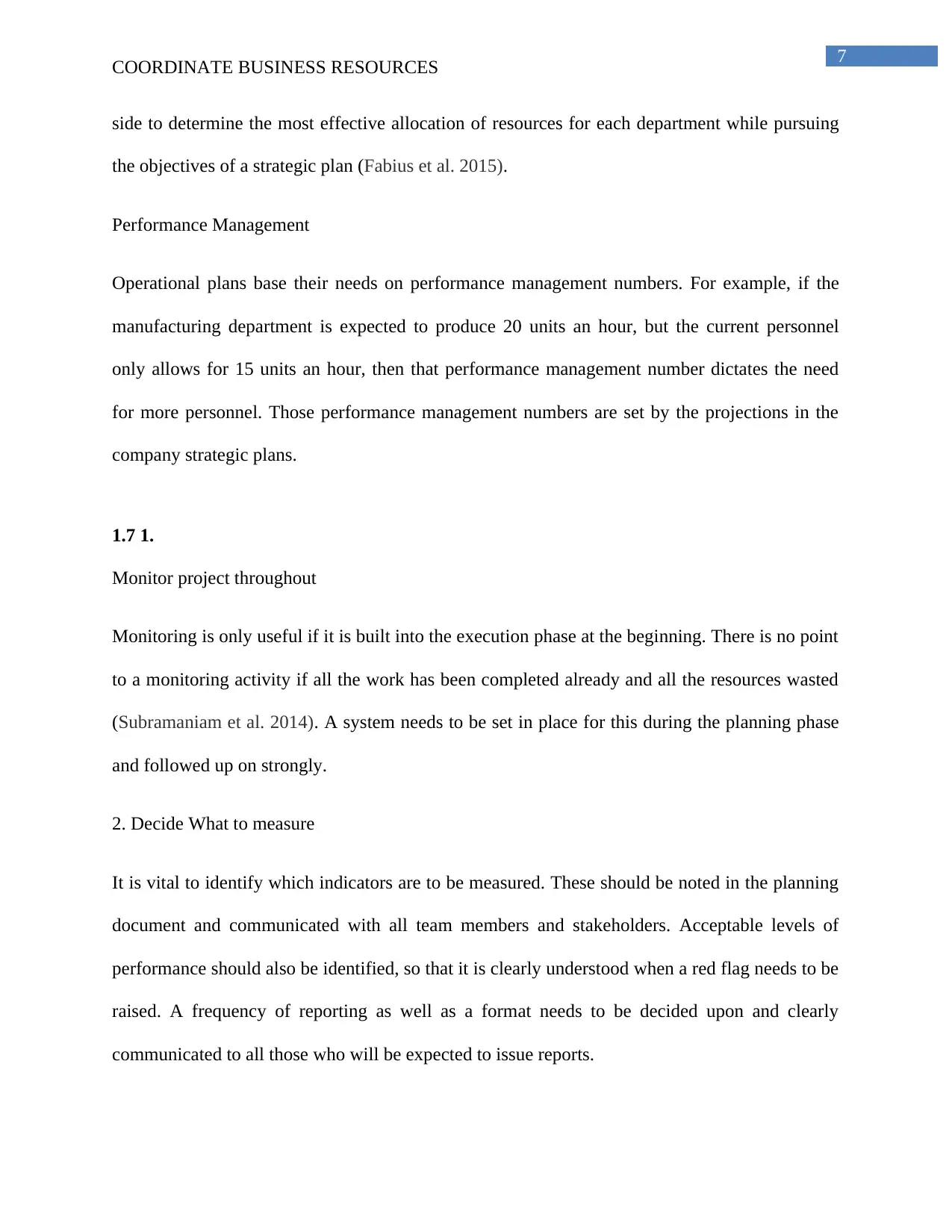
7
COORDINATE BUSINESS RESOURCES
side to determine the most effective allocation of resources for each department while pursuing
the objectives of a strategic plan (Fabius et al. 2015).
Performance Management
Operational plans base their needs on performance management numbers. For example, if the
manufacturing department is expected to produce 20 units an hour, but the current personnel
only allows for 15 units an hour, then that performance management number dictates the need
for more personnel. Those performance management numbers are set by the projections in the
company strategic plans.
1.7 1.
Monitor project throughout
Monitoring is only useful if it is built into the execution phase at the beginning. There is no point
to a monitoring activity if all the work has been completed already and all the resources wasted
(Subramaniam et al. 2014). A system needs to be set in place for this during the planning phase
and followed up on strongly.
2. Decide What to measure
It is vital to identify which indicators are to be measured. These should be noted in the planning
document and communicated with all team members and stakeholders. Acceptable levels of
performance should also be identified, so that it is clearly understood when a red flag needs to be
raised. A frequency of reporting as well as a format needs to be decided upon and clearly
communicated to all those who will be expected to issue reports.
COORDINATE BUSINESS RESOURCES
side to determine the most effective allocation of resources for each department while pursuing
the objectives of a strategic plan (Fabius et al. 2015).
Performance Management
Operational plans base their needs on performance management numbers. For example, if the
manufacturing department is expected to produce 20 units an hour, but the current personnel
only allows for 15 units an hour, then that performance management number dictates the need
for more personnel. Those performance management numbers are set by the projections in the
company strategic plans.
1.7 1.
Monitor project throughout
Monitoring is only useful if it is built into the execution phase at the beginning. There is no point
to a monitoring activity if all the work has been completed already and all the resources wasted
(Subramaniam et al. 2014). A system needs to be set in place for this during the planning phase
and followed up on strongly.
2. Decide What to measure
It is vital to identify which indicators are to be measured. These should be noted in the planning
document and communicated with all team members and stakeholders. Acceptable levels of
performance should also be identified, so that it is clearly understood when a red flag needs to be
raised. A frequency of reporting as well as a format needs to be decided upon and clearly
communicated to all those who will be expected to issue reports.
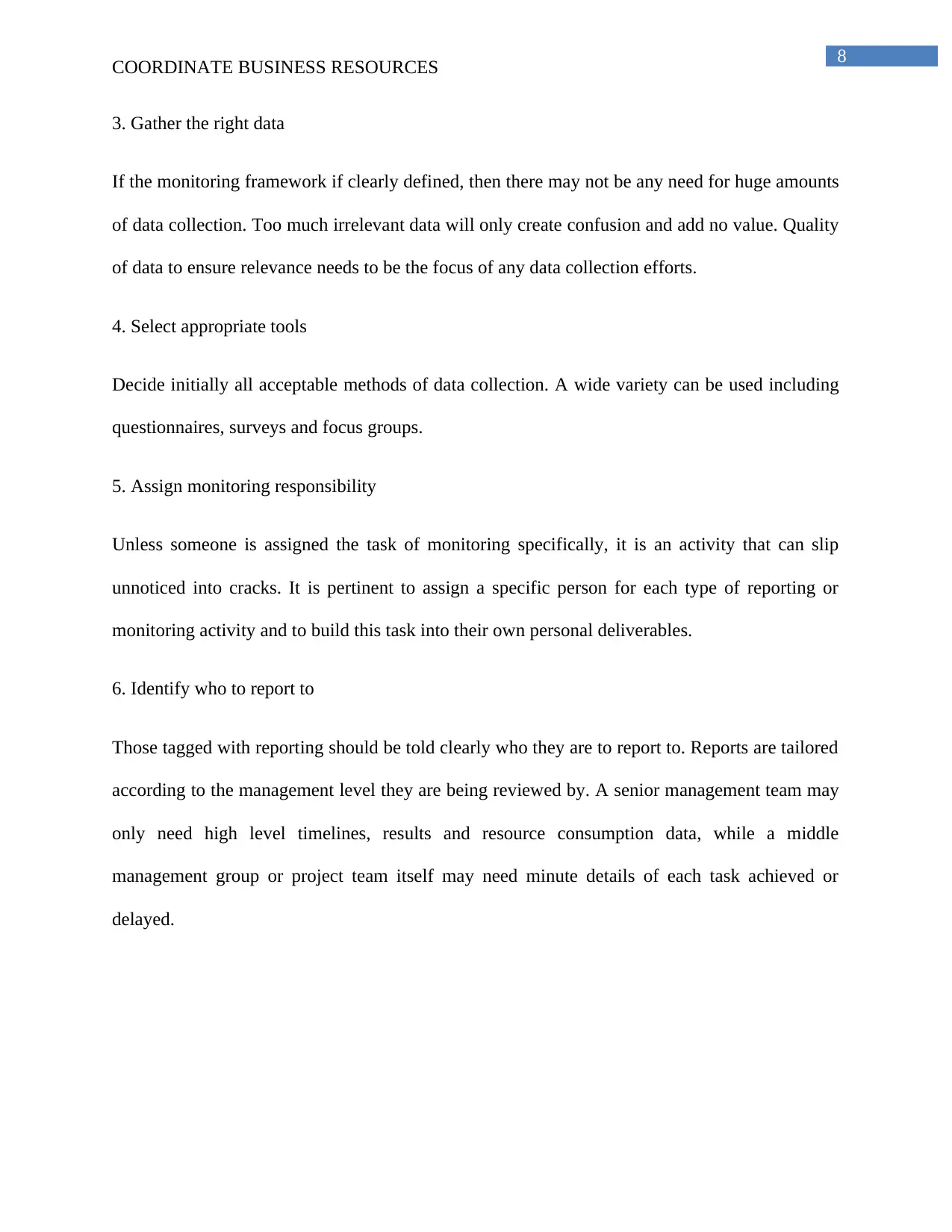
8
COORDINATE BUSINESS RESOURCES
3. Gather the right data
If the monitoring framework if clearly defined, then there may not be any need for huge amounts
of data collection. Too much irrelevant data will only create confusion and add no value. Quality
of data to ensure relevance needs to be the focus of any data collection efforts.
4. Select appropriate tools
Decide initially all acceptable methods of data collection. A wide variety can be used including
questionnaires, surveys and focus groups.
5. Assign monitoring responsibility
Unless someone is assigned the task of monitoring specifically, it is an activity that can slip
unnoticed into cracks. It is pertinent to assign a specific person for each type of reporting or
monitoring activity and to build this task into their own personal deliverables.
6. Identify who to report to
Those tagged with reporting should be told clearly who they are to report to. Reports are tailored
according to the management level they are being reviewed by. A senior management team may
only need high level timelines, results and resource consumption data, while a middle
management group or project team itself may need minute details of each task achieved or
delayed.
COORDINATE BUSINESS RESOURCES
3. Gather the right data
If the monitoring framework if clearly defined, then there may not be any need for huge amounts
of data collection. Too much irrelevant data will only create confusion and add no value. Quality
of data to ensure relevance needs to be the focus of any data collection efforts.
4. Select appropriate tools
Decide initially all acceptable methods of data collection. A wide variety can be used including
questionnaires, surveys and focus groups.
5. Assign monitoring responsibility
Unless someone is assigned the task of monitoring specifically, it is an activity that can slip
unnoticed into cracks. It is pertinent to assign a specific person for each type of reporting or
monitoring activity and to build this task into their own personal deliverables.
6. Identify who to report to
Those tagged with reporting should be told clearly who they are to report to. Reports are tailored
according to the management level they are being reviewed by. A senior management team may
only need high level timelines, results and resource consumption data, while a middle
management group or project team itself may need minute details of each task achieved or
delayed.
⊘ This is a preview!⊘
Do you want full access?
Subscribe today to unlock all pages.

Trusted by 1+ million students worldwide
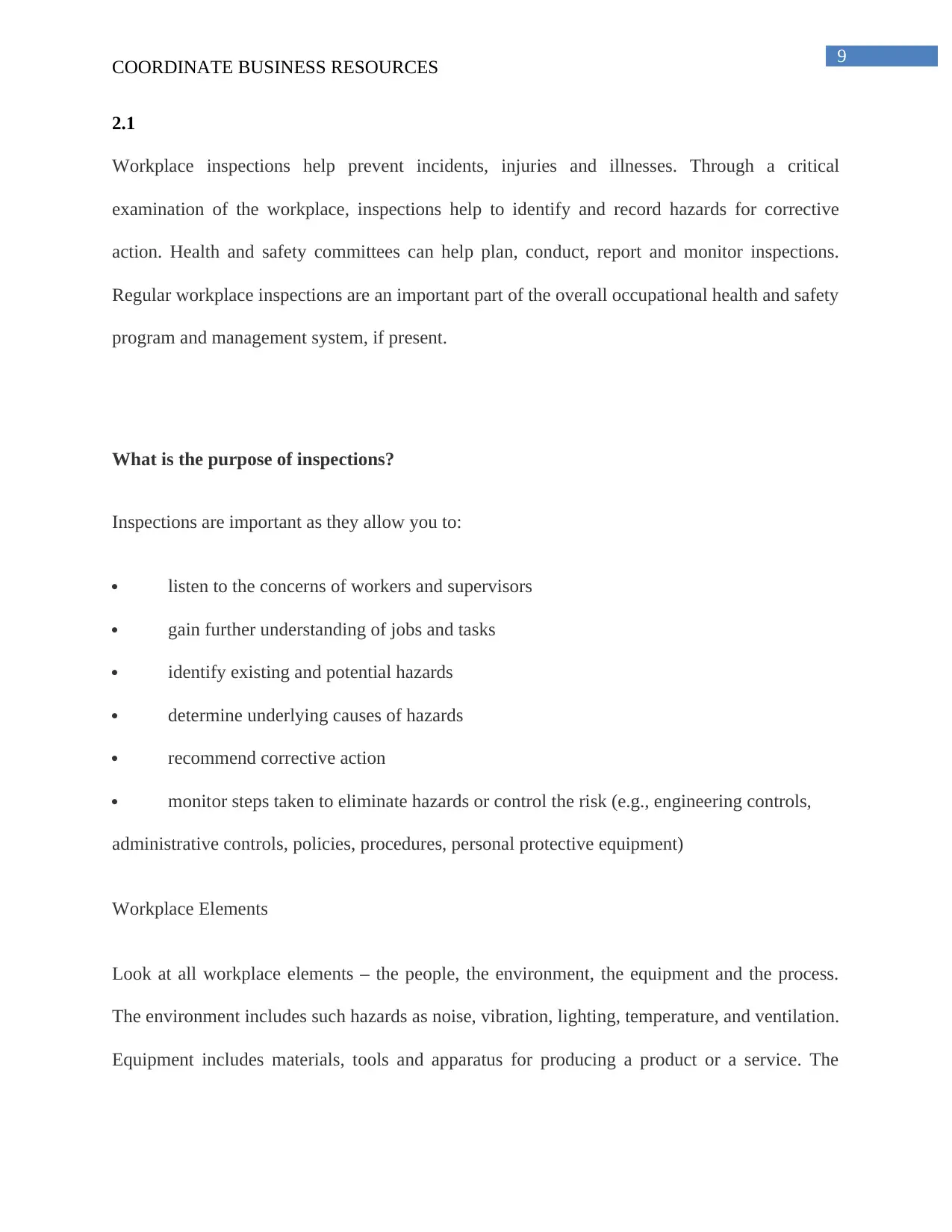
9
COORDINATE BUSINESS RESOURCES
2.1
Workplace inspections help prevent incidents, injuries and illnesses. Through a critical
examination of the workplace, inspections help to identify and record hazards for corrective
action. Health and safety committees can help plan, conduct, report and monitor inspections.
Regular workplace inspections are an important part of the overall occupational health and safety
program and management system, if present.
What is the purpose of inspections?
Inspections are important as they allow you to:
listen to the concerns of workers and supervisors
gain further understanding of jobs and tasks
identify existing and potential hazards
determine underlying causes of hazards
recommend corrective action
monitor steps taken to eliminate hazards or control the risk (e.g., engineering controls,
administrative controls, policies, procedures, personal protective equipment)
Workplace Elements
Look at all workplace elements – the people, the environment, the equipment and the process.
The environment includes such hazards as noise, vibration, lighting, temperature, and ventilation.
Equipment includes materials, tools and apparatus for producing a product or a service. The
COORDINATE BUSINESS RESOURCES
2.1
Workplace inspections help prevent incidents, injuries and illnesses. Through a critical
examination of the workplace, inspections help to identify and record hazards for corrective
action. Health and safety committees can help plan, conduct, report and monitor inspections.
Regular workplace inspections are an important part of the overall occupational health and safety
program and management system, if present.
What is the purpose of inspections?
Inspections are important as they allow you to:
listen to the concerns of workers and supervisors
gain further understanding of jobs and tasks
identify existing and potential hazards
determine underlying causes of hazards
recommend corrective action
monitor steps taken to eliminate hazards or control the risk (e.g., engineering controls,
administrative controls, policies, procedures, personal protective equipment)
Workplace Elements
Look at all workplace elements – the people, the environment, the equipment and the process.
The environment includes such hazards as noise, vibration, lighting, temperature, and ventilation.
Equipment includes materials, tools and apparatus for producing a product or a service. The
Paraphrase This Document
Need a fresh take? Get an instant paraphrase of this document with our AI Paraphraser
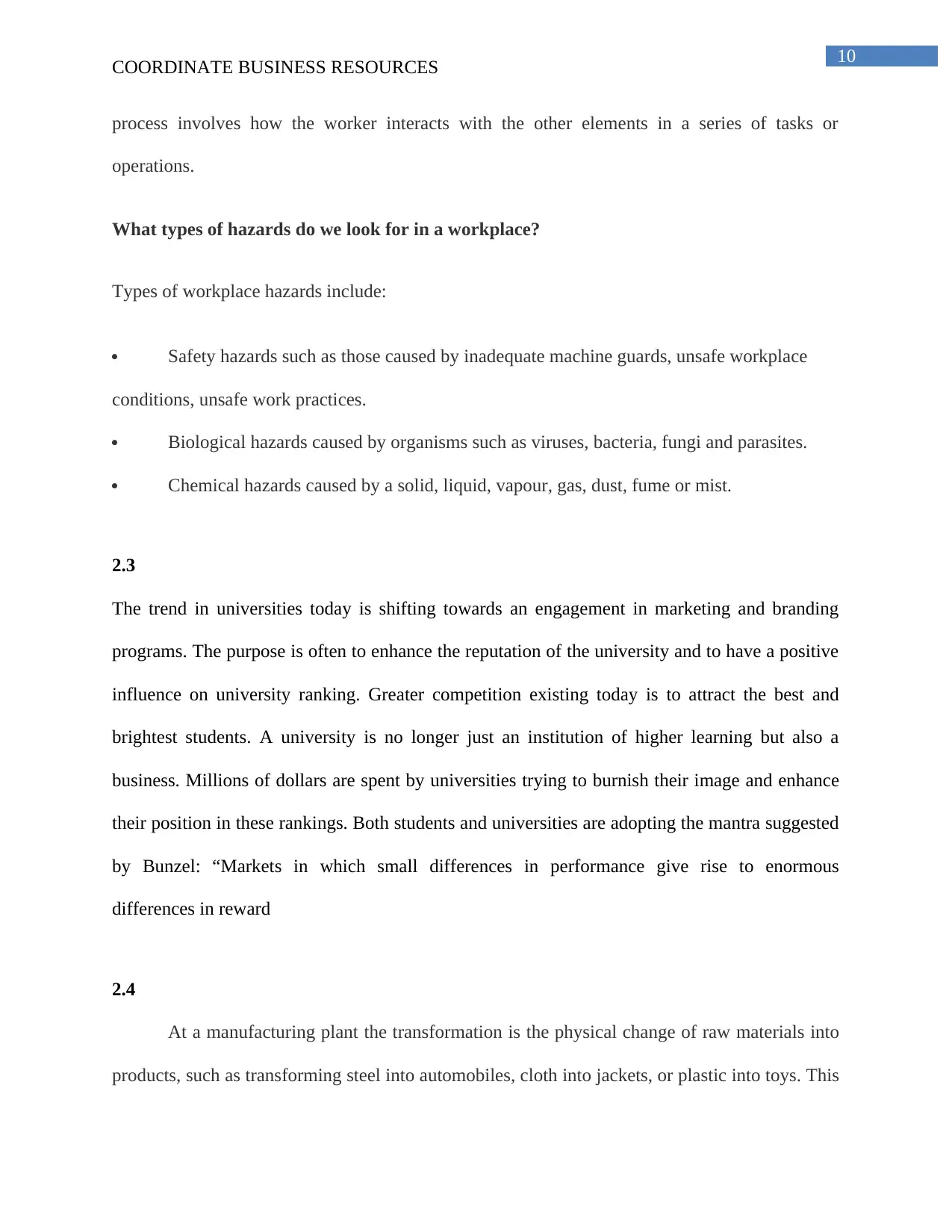
10
COORDINATE BUSINESS RESOURCES
process involves how the worker interacts with the other elements in a series of tasks or
operations.
What types of hazards do we look for in a workplace?
Types of workplace hazards include:
Safety hazards such as those caused by inadequate machine guards, unsafe workplace
conditions, unsafe work practices.
Biological hazards caused by organisms such as viruses, bacteria, fungi and parasites.
Chemical hazards caused by a solid, liquid, vapour, gas, dust, fume or mist.
2.3
The trend in universities today is shifting towards an engagement in marketing and branding
programs. The purpose is often to enhance the reputation of the university and to have a positive
influence on university ranking. Greater competition existing today is to attract the best and
brightest students. A university is no longer just an institution of higher learning but also a
business. Millions of dollars are spent by universities trying to burnish their image and enhance
their position in these rankings. Both students and universities are adopting the mantra suggested
by Bunzel: “Markets in which small differences in performance give rise to enormous
differences in reward
2.4
At a manufacturing plant the transformation is the physical change of raw materials into
products, such as transforming steel into automobiles, cloth into jackets, or plastic into toys. This
COORDINATE BUSINESS RESOURCES
process involves how the worker interacts with the other elements in a series of tasks or
operations.
What types of hazards do we look for in a workplace?
Types of workplace hazards include:
Safety hazards such as those caused by inadequate machine guards, unsafe workplace
conditions, unsafe work practices.
Biological hazards caused by organisms such as viruses, bacteria, fungi and parasites.
Chemical hazards caused by a solid, liquid, vapour, gas, dust, fume or mist.
2.3
The trend in universities today is shifting towards an engagement in marketing and branding
programs. The purpose is often to enhance the reputation of the university and to have a positive
influence on university ranking. Greater competition existing today is to attract the best and
brightest students. A university is no longer just an institution of higher learning but also a
business. Millions of dollars are spent by universities trying to burnish their image and enhance
their position in these rankings. Both students and universities are adopting the mantra suggested
by Bunzel: “Markets in which small differences in performance give rise to enormous
differences in reward
2.4
At a manufacturing plant the transformation is the physical change of raw materials into
products, such as transforming steel into automobiles, cloth into jackets, or plastic into toys. This
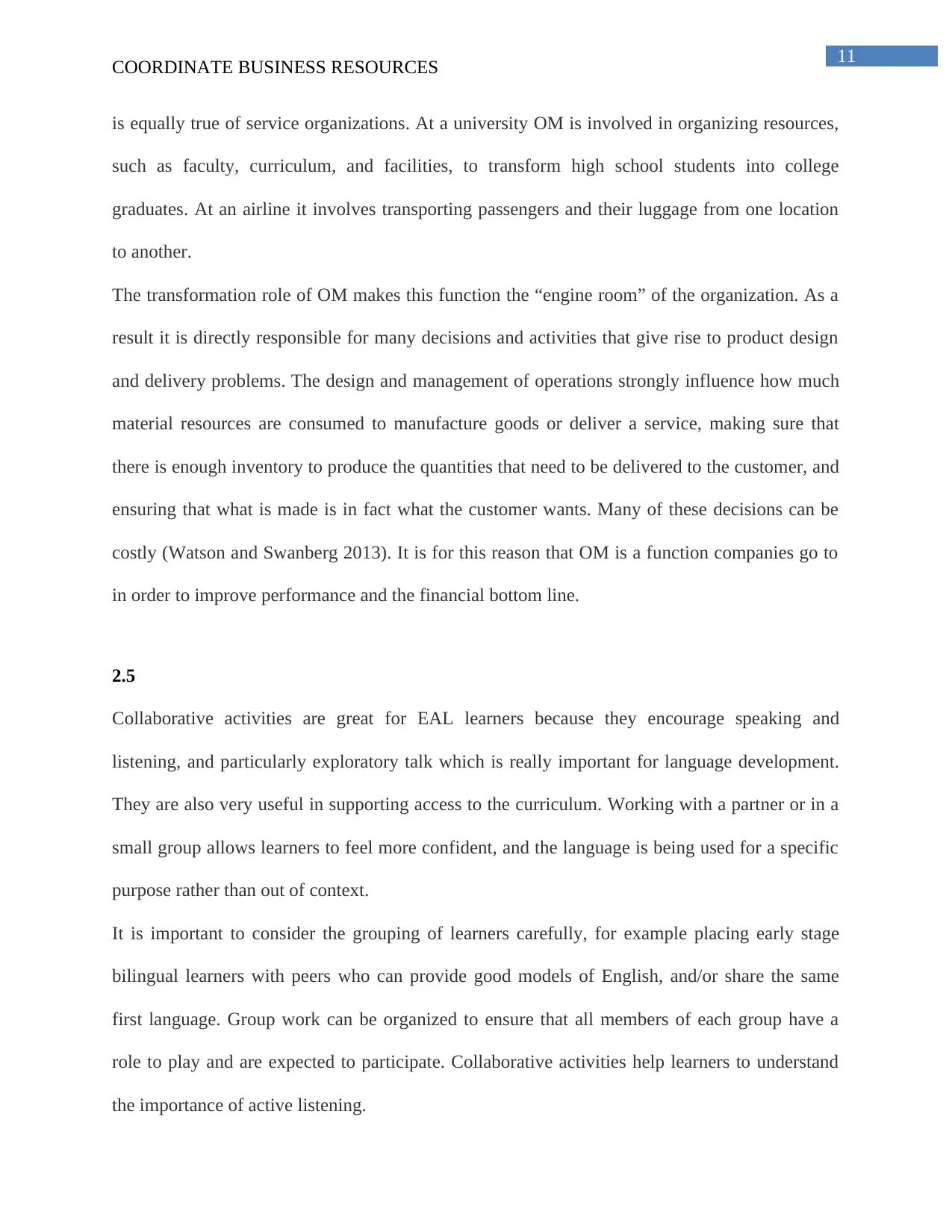
11
COORDINATE BUSINESS RESOURCES
is equally true of service organizations. At a university OM is involved in organizing resources,
such as faculty, curriculum, and facilities, to transform high school students into college
graduates. At an airline it involves transporting passengers and their luggage from one location
to another.
The transformation role of OM makes this function the “engine room” of the organization. As a
result it is directly responsible for many decisions and activities that give rise to product design
and delivery problems. The design and management of operations strongly influence how much
material resources are consumed to manufacture goods or deliver a service, making sure that
there is enough inventory to produce the quantities that need to be delivered to the customer, and
ensuring that what is made is in fact what the customer wants. Many of these decisions can be
costly (Watson and Swanberg 2013). It is for this reason that OM is a function companies go to
in order to improve performance and the financial bottom line.
2.5
Collaborative activities are great for EAL learners because they encourage speaking and
listening, and particularly exploratory talk which is really important for language development.
They are also very useful in supporting access to the curriculum. Working with a partner or in a
small group allows learners to feel more confident, and the language is being used for a specific
purpose rather than out of context.
It is important to consider the grouping of learners carefully, for example placing early stage
bilingual learners with peers who can provide good models of English, and/or share the same
first language. Group work can be organized to ensure that all members of each group have a
role to play and are expected to participate. Collaborative activities help learners to understand
the importance of active listening.
COORDINATE BUSINESS RESOURCES
is equally true of service organizations. At a university OM is involved in organizing resources,
such as faculty, curriculum, and facilities, to transform high school students into college
graduates. At an airline it involves transporting passengers and their luggage from one location
to another.
The transformation role of OM makes this function the “engine room” of the organization. As a
result it is directly responsible for many decisions and activities that give rise to product design
and delivery problems. The design and management of operations strongly influence how much
material resources are consumed to manufacture goods or deliver a service, making sure that
there is enough inventory to produce the quantities that need to be delivered to the customer, and
ensuring that what is made is in fact what the customer wants. Many of these decisions can be
costly (Watson and Swanberg 2013). It is for this reason that OM is a function companies go to
in order to improve performance and the financial bottom line.
2.5
Collaborative activities are great for EAL learners because they encourage speaking and
listening, and particularly exploratory talk which is really important for language development.
They are also very useful in supporting access to the curriculum. Working with a partner or in a
small group allows learners to feel more confident, and the language is being used for a specific
purpose rather than out of context.
It is important to consider the grouping of learners carefully, for example placing early stage
bilingual learners with peers who can provide good models of English, and/or share the same
first language. Group work can be organized to ensure that all members of each group have a
role to play and are expected to participate. Collaborative activities help learners to understand
the importance of active listening.
⊘ This is a preview!⊘
Do you want full access?
Subscribe today to unlock all pages.

Trusted by 1+ million students worldwide
1 out of 14
Related Documents
Your All-in-One AI-Powered Toolkit for Academic Success.
+13062052269
info@desklib.com
Available 24*7 on WhatsApp / Email
![[object Object]](/_next/static/media/star-bottom.7253800d.svg)
Unlock your academic potential
Copyright © 2020–2025 A2Z Services. All Rights Reserved. Developed and managed by ZUCOL.





